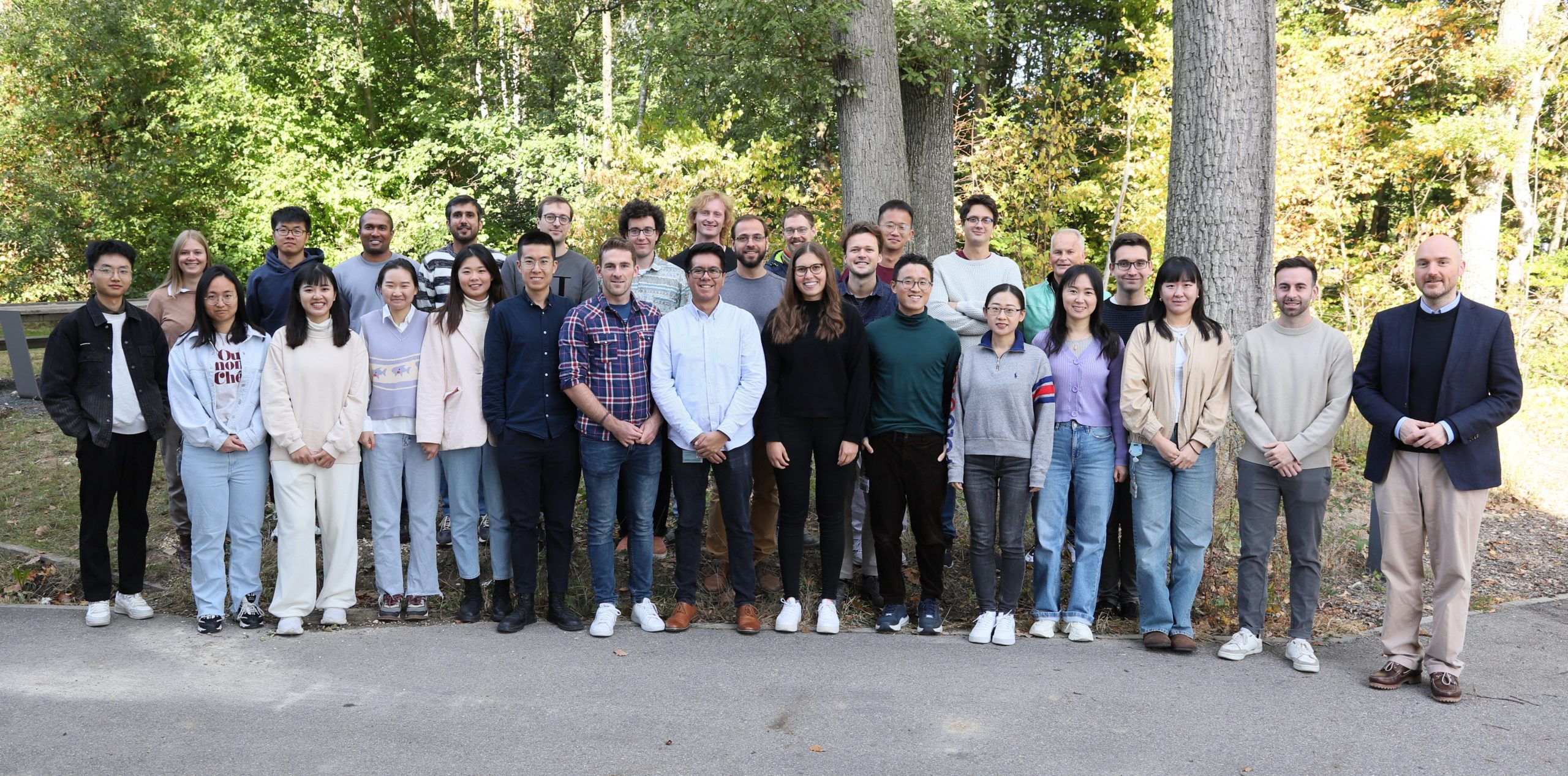HIU-Newsletter
You a scientist yourself? A journalist, a political decision-maker or business representative? In our newsletters we compile the latest battery research news for you. Specially tailored to your personal area of interest.
The research group "Electrochemical Energy Storage Materials" focuses on the development and research of alternative electrode materials and electrolyte systems for lithium-based batteries and related energy storage technologies. The aim is to develop a deeper understanding of the underlying mechanisms and processes that enable and determine the reversible storage of charge carriers and their efficient transport.
The development of new, sustainable and improved active and inactive materials for lithium-based and Li-free battery systems is essential for a successful energy transition. The diversification of the usable energy storage technologies and their optimization for selected applications is seen as a decisive factor. Examples of the work of the group are the research of alternative active materials for the negative electrode based on a combination of alloy and conversion reactions, the targeted introduction of redox-active elements in insertion materials, as well as polymer-based electrolyte systems and organic battery technologies. The goal of better understanding the processes and reactions taking place also always serves the parallel goal of improving and advancing the performance of the materials and electrochemical energy storage as a whole. To this end, the group can fall back on extensive know-how in the synthesis and characterization of energy storage materials and systems and also cooperates with a large number of groups with complementary competencies in Germany, Europe and worldwide.
This research group is partially funded by the Deutsche Forschungsgesellschaft (DFG) through the Cluster of Excellence POLiS.

(images will be uploaded shortly)
The vast majority of commercial lithium batteries is based on the use of insertion-type or intercalation-type electrode materials. Such materials can reversibly host the charge carrier cations without substantial changes (or the degradation) of the crystal structure. Increasing the reversibility of this process and enhancing the stability of the interface with the electrolyte, especially at very low and very high voltages, is of essential importance to further improve the performance of such materials. In addition to the development of a better understanding and the modification and optimization these compounds (including the realization of fine-tuned electrolyte compositions), we are working on a new insertion-type mechanism, for which we are introducing highly redox-active elements into such structurally stable frameworks in order to boost the achievable capacity by reversibly hosting substantially more charge carrier cations.
Targeting higher specific capacities and (potentially) higher energy and power densities, we are also studying alternative charge carrier storage mechanisms, including conversion-type and alloying-type materials as well as materials that combine these two mechanisms in one single compound – so-called conversion/alloying materials. While (understoichiometric) silicon (oxide), for instance, has already reached the commercial stage – despite the extensive volume variation upon cycling, conversion materials are still at the research & development level. Of particular importance in this field is the identification of the origin of the extensive voltage hysteresis between the charge and discharge process, which is intrinsically limiting the eventual energy efficiency of the corresponding full-cells. One approach to overcome the related challenges is the transition to conversion/alloying materials with the goal to synergistically combine the two mechanisms and their rather complementary benefits, including the development of completely new materials based on an enhanced comprehension of the reaction mechanism and the impact of the different elements comprised.
Lithium-metal electrodes and so-called “anode-free” concepts, which are eventually also resulting in lithium-metal electrodes upon charge when the lithium from the positive electrode is plated at the negative electrode, are the “holy grail” of lithium battery research, as they promise the highest energy density possible in combination with suitable cathode active materials. Our group is studying the impact factors that are determining the homogeneity and reversibility of the lithium deposition, with the objective to realize highly efficient lithium plating and stripping by stabilizing the interface between the electrode and the liquid or solid electrolyte.
The replacement of inorganic active materials by more sustainable organic materials has attracted a continuously increasing attention in recent years due to the great progress that has been achieved in this field. In addition to the development of new organic active materials and completely metal-free organic (solid-state) battery cells, a major focus of our work is dedicated to the development of an in-depth understanding of the electrochemical charge storage and charge transport processes occurring in such materials – at the molecular, particle, electrode and cell level – in combination with the design of advanced electrode architectures.d cost efficiency. This work is accompanied by the investigation of advanced hierarchical secondary particle architectures and the implementation of nanostructured, electronically conductive matrices to ensure long-term cycling stability and high rate capability. Eventually, the overall target is the realization of demonstrator full-cells, comprising “next generation” electrolyte systems and cathode active materials.
Most state-of-the-art (rechargeable) battery electrodes are composed of the active material and additional (inactive) components such as a conductive carbon additive and a polymer binder as well as a (metallic) current collector. In fact, essential improvement of the energy and power density of commercial battery cells has been achieved by improving the electrode composition and the electrode manufacturing process. We are specifically investigating the potential use of environmentally friendly processes and the potential use of bio-derived inactive components, especially for lithium-ion cathode materials, for which this is particularly challenging.
Solid-state electrolytes such as polymers are considered key for the use of metallic anodes such as lithium, potentially hindering dendritic metal deposition. Additionally, they may enable an enhanced safety as well as good processability and adhesion to the metal electrode surface. Polyether-based electrolytes are, as a matter of fact, commercial already, but the operation of such lithium-metal-polymer batteries is limited to elevated temperatures around the melting point of the polymer. Moreover, the rather low stability towards oxidation commonly does not allow for the use of high-energy cathode materials operating at potentials beyond 4 V. Besides a further understanding of the charge transport mechanism in these electrolyte systems and the processes taking place at the interface with the metallic anode, our work is particularly focused on single-ion conducting polymer-based electrolytes, which enable the use at ambient temperatures and the combination with state-of-the-art lithium-ion cathode materials (e.g. NMC811), including the realization and in-depth understanding of alternative or modified charge transport mechanisms.
As science ideally does not know any barriers, we are collaborating with several international research groups, each of them having great expertise in their field, and we will be more than grateful to further extend these collaborative activities in future.
(information will be uploaded shortly)
| Acronym
(Role) |
Research Subject | Funding Organization | Duration (in years) | Funding Period |
| NISE | New ionomers for (quasi)-solid-state high-energy lithium-battery cathodes | KIT-IRGA (UGA) | 3 | 2024-2027 |
| MONaBE | Organic Na-ion batteries | BMBF | 1 | 2024 |
| NESBA | Na-ion battery cathodes | DAAD/BMBF (collaboration with Serbia) | 2 | 2024-2025 |
| SACCESS-2 (PI) | Polymers based on advanced squaric acid amides as new battery electrode materials | DFG | 3 | 2024-2027 |
| ENTISE (PI) | Sodium-ion batteries for stationary applications | BMBF | 3 | 2024-2027 |
| POLiS (PI) | Post Lithium Storage Cluster of Excellence | DFG | 3 | 2023-2025 |
| HighSafe-III (PI & Coordinator) | “Anode-free” Li batteries and ionic liquid-based electrolytes | BMBF-MOST | 3 | 2023-2026 |
| VORAN (PI) | Sodium-ion batteries with a new cell design for stationary storage devices | BMWK | 3 | 2024-2027 |
| RIDERS (PI) | Training in cutting-edge battery technologies | European Commission (MSCA) | 4 | 2024-2027 |
| PRONTO (PI) | Novel cell design for sodium-ion batteries | MWAT – BaWü | 2 | 2022-2024 |
| SiGNE (PI) | High-energy lithium-ion batteries | European Commission | 4 | 2022-2026 |
| LISI-2 (PI) | Lithium/solid electrolyte interface | BMBF-DOE | 3 | 2022-2025 |
| LILLINT-2 (Co-PI) | Thermodynamic and kinetic stability of the lithium-liquid electrolyte interface | BMBF-DOE | 3 | 2022-2025 |
| RACER (PI) | Highly Redox-active Atomic Centers in Electrode Materials for Rechargeable Batteries | ERC Starting Grant – European Commission | 5 | 2022-2027 |
| MATISSE (PI) | Structural batteries for aircraft applications | European Commission | 3 | 2022-2025 |
| FB2-Hybrid (PI) | Competence cluster on all-solid-state batteries – Hybrid systems | BMBF | 3 | 2021-2024 |
| FB2-Polymer (Co-PI) | Competence cluster on all-solid-state batteries – Polymers | BMBF | 3 | 2021-2024 |
| HyPerium (PI) | Hybrid solid-state electrolytes for sodium(‑ion) batteries | BMBF | 3 | 2021-2024 |
| ALANO (Co-PI) | Alternative concepts for the negative electrode in solid-state batteries | BMBF | 3 | 2021-2024 |
| REFA (Co-PI) | Three-electrode cells for solid electrolytes | BMWi | 3 | 2021-2024 |
| H2O-LiMO (PI) | Water sensitivity of lithium battery cathodes | DFG | 2 | 2021-2023 |
| HighSafe-II (Co-PI & Co‑Coordinator) | “Anode-free” Li batteries and ionic liquid-based electrolytes | BMBF-MOST | 3 | 2020-2023 |
| SACCESS (PI) | Polymers based on squaric acid amides and cyclopropenium cations as new battery electrode materials | DFG | 3 | 2020-2023 |
| M2V2LIB (PI) | Modelling the microstructural volume variations and the resulting mechanical properties in lithium-ion battery electrodes | YIN (KIT) | <1 | 2020 |
| ExcellBattUlm (Co-PI) | Sustainable and safe high-performance energy materials | BMBF | 3 | 2019-2022 |
| MOLIBE (Coordinator) | Metal- and liquid-free organic lithium-ion batteries | BMBF-ANR | 4 | 2019-2023 |
| SIPED-BAT (PI) | Single-ion polymer electrolytes for sustainable and safe high-energy density batteries | IDEX (UGA) | 3 | 2019-2022 |
| LISI (PI) | Lithium/solid electrolyte interface | BMBF-DOE | 3 | 2019-2022 |
| LILLINT (Co-PI) | Thermodynamic and kinetic stability of the lithium-liquid electrolyte interface | BMBF-DOE | 3 | 2019-2022 |
| FestBatt (Co-PI) | Competence cluster on all-solid-state batteries – Polymers | BMBF | 3 | 2018-2021 |
| OFELIA (PI) | Conductivity cell for solid electrolytes incl. online thickness determination | DBU | 1 | 2018-2019 |
| NEW E2 (PI) | Alternative anodes for Li-ion batteries | Vector Foundation | 4 | 2017-2020 |
| ABILE (Co-PI) | Air batteries with ionic liquid electrolytes | BMW AG | 3 | 2013-2016 |
(images will be uploaded shortly)
The vast majority of commercial lithium batteries is based on the use of insertion-type or intercalation-type electrode materials. Such materials can reversibly host the charge carrier cations without substantial changes (or the degradation) of the crystal structure. Increasing the reversibility of this process and enhancing the stability of the interface with the electrolyte, especially at very low and very high voltages, is of essential importance to further improve the performance of such materials. In addition to the development of a better understanding and the modification and optimization these compounds (including the realization of fine-tuned electrolyte compositions), we are working on a new insertion-type mechanism, for which we are introducing highly redox-active elements into such structurally stable frameworks in order to boost the achievable capacity by reversibly hosting substantially more charge carrier cations.
Targeting higher specific capacities and (potentially) higher energy and power densities, we are also studying alternative charge carrier storage mechanisms, including conversion-type and alloying-type materials as well as materials that combine these two mechanisms in one single compound – so-called conversion/alloying materials. While (understoichiometric) silicon (oxide), for instance, has already reached the commercial stage – despite the extensive volume variation upon cycling, conversion materials are still at the research & development level. Of particular importance in this field is the identification of the origin of the extensive voltage hysteresis between the charge and discharge process, which is intrinsically limiting the eventual energy efficiency of the corresponding full-cells. One approach to overcome the related challenges is the transition to conversion/alloying materials with the goal to synergistically combine the two mechanisms and their rather complementary benefits, including the development of completely new materials based on an enhanced comprehension of the reaction mechanism and the impact of the different elements comprised.
Lithium-metal electrodes and so-called “anode-free” concepts, which are eventually also resulting in lithium-metal electrodes upon charge when the lithium from the positive electrode is plated at the negative electrode, are the “holy grail” of lithium battery research, as they promise the highest energy density possible in combination with suitable cathode active materials. Our group is studying the impact factors that are determining the homogeneity and reversibility of the lithium deposition, with the objective to realize highly efficient lithium plating and stripping by stabilizing the interface between the electrode and the liquid or solid electrolyte.
The replacement of inorganic active materials by more sustainable organic materials has attracted a continuously increasing attention in recent years due to the great progress that has been achieved in this field. In addition to the development of new organic active materials and completely metal-free organic (solid-state) battery cells, a major focus of our work is dedicated to the development of an in-depth understanding of the electrochemical charge storage and charge transport processes occurring in such materials – at the molecular, particle, electrode and cell level – in combination with the design of advanced electrode architectures.d cost efficiency. This work is accompanied by the investigation of advanced hierarchical secondary particle architectures and the implementation of nanostructured, electronically conductive matrices to ensure long-term cycling stability and high rate capability. Eventually, the overall target is the realization of demonstrator full-cells, comprising “next generation” electrolyte systems and cathode active materials.
Most state-of-the-art (rechargeable) battery electrodes are composed of the active material and additional (inactive) components such as a conductive carbon additive and a polymer binder as well as a (metallic) current collector. In fact, essential improvement of the energy and power density of commercial battery cells has been achieved by improving the electrode composition and the electrode manufacturing process. We are specifically investigating the potential use of environmentally friendly processes and the potential use of bio-derived inactive components, especially for lithium-ion cathode materials, for which this is particularly challenging.
Solid-state electrolytes such as polymers are considered key for the use of metallic anodes such as lithium, potentially hindering dendritic metal deposition. Additionally, they may enable an enhanced safety as well as good processability and adhesion to the metal electrode surface. Polyether-based electrolytes are, as a matter of fact, commercial already, but the operation of such lithium-metal-polymer batteries is limited to elevated temperatures around the melting point of the polymer. Moreover, the rather low stability towards oxidation commonly does not allow for the use of high-energy cathode materials operating at potentials beyond 4 V. Besides a further understanding of the charge transport mechanism in these electrolyte systems and the processes taking place at the interface with the metallic anode, our work is particularly focused on single-ion conducting polymer-based electrolytes, which enable the use at ambient temperatures and the combination with state-of-the-art lithium-ion cathode materials (e.g. NMC811), including the realization and in-depth understanding of alternative or modified charge transport mechanisms.
As science ideally does not know any barriers, we are collaborating with several international research groups, each of them having great expertise in their field, and we will be more than grateful to further extend these collaborative activities in future.
(information will be uploaded shortly)
| Acronym
(Role) |
Research Subject | Funding Organization | Duration (in years) | Funding Period |
| NISE | New ionomers for (quasi)-solid-state high-energy lithium-battery cathodes | KIT-IRGA (UGA) | 3 | 2024-2027 |
| MONaBE | Organic Na-ion batteries | BMBF | 1 | 2024 |
| NESBA | Na-ion battery cathodes | DAAD/BMBF (collaboration with Serbia) | 2 | 2024-2025 |
| SACCESS-2 (PI) | Polymers based on advanced squaric acid amides as new battery electrode materials | DFG | 3 | 2024-2027 |
| ENTISE (PI) | Sodium-ion batteries for stationary applications | BMBF | 3 | 2024-2027 |
| POLiS (PI) | Post Lithium Storage Cluster of Excellence | DFG | 3 | 2023-2025 |
| HighSafe-III (PI & Coordinator) | “Anode-free” Li batteries and ionic liquid-based electrolytes | BMBF-MOST | 3 | 2023-2026 |
| VORAN (PI) | Sodium-ion batteries with a new cell design for stationary storage devices | BMWK | 3 | 2024-2027 |
| RIDERS (PI) | Training in cutting-edge battery technologies | European Commission (MSCA) | 4 | 2024-2027 |
| PRONTO (PI) | Novel cell design for sodium-ion batteries | MWAT – BaWü | 2 | 2022-2024 |
| SiGNE (PI) | High-energy lithium-ion batteries | European Commission | 4 | 2022-2026 |
| LISI-2 (PI) | Lithium/solid electrolyte interface | BMBF-DOE | 3 | 2022-2025 |
| LILLINT-2 (Co-PI) | Thermodynamic and kinetic stability of the lithium-liquid electrolyte interface | BMBF-DOE | 3 | 2022-2025 |
| RACER (PI) | Highly Redox-active Atomic Centers in Electrode Materials for Rechargeable Batteries | ERC Starting Grant – European Commission | 5 | 2022-2027 |
| MATISSE (PI) | Structural batteries for aircraft applications | European Commission | 3 | 2022-2025 |
| FB2-Hybrid (PI) | Competence cluster on all-solid-state batteries – Hybrid systems | BMBF | 3 | 2021-2024 |
| FB2-Polymer (Co-PI) | Competence cluster on all-solid-state batteries – Polymers | BMBF | 3 | 2021-2024 |
| HyPerium (PI) | Hybrid solid-state electrolytes for sodium(‑ion) batteries | BMBF | 3 | 2021-2024 |
| ALANO (Co-PI) | Alternative concepts for the negative electrode in solid-state batteries | BMBF | 3 | 2021-2024 |
| REFA (Co-PI) | Three-electrode cells for solid electrolytes | BMWi | 3 | 2021-2024 |
| H2O-LiMO (PI) | Water sensitivity of lithium battery cathodes | DFG | 2 | 2021-2023 |
| HighSafe-II (Co-PI & Co‑Coordinator) | “Anode-free” Li batteries and ionic liquid-based electrolytes | BMBF-MOST | 3 | 2020-2023 |
| SACCESS (PI) | Polymers based on squaric acid amides and cyclopropenium cations as new battery electrode materials | DFG | 3 | 2020-2023 |
| M2V2LIB (PI) | Modelling the microstructural volume variations and the resulting mechanical properties in lithium-ion battery electrodes | YIN (KIT) | <1 | 2020 |
| ExcellBattUlm (Co-PI) | Sustainable and safe high-performance energy materials | BMBF | 3 | 2019-2022 |
| MOLIBE (Coordinator) | Metal- and liquid-free organic lithium-ion batteries | BMBF-ANR | 4 | 2019-2023 |
| SIPED-BAT (PI) | Single-ion polymer electrolytes for sustainable and safe high-energy density batteries | IDEX (UGA) | 3 | 2019-2022 |
| LISI (PI) | Lithium/solid electrolyte interface | BMBF-DOE | 3 | 2019-2022 |
| LILLINT (Co-PI) | Thermodynamic and kinetic stability of the lithium-liquid electrolyte interface | BMBF-DOE | 3 | 2019-2022 |
| FestBatt (Co-PI) | Competence cluster on all-solid-state batteries – Polymers | BMBF | 3 | 2018-2021 |
| OFELIA (PI) | Conductivity cell for solid electrolytes incl. online thickness determination | DBU | 1 | 2018-2019 |
| NEW E2 (PI) | Alternative anodes for Li-ion batteries | Vector Foundation | 4 | 2017-2020 |
| ABILE (Co-PI) | Air batteries with ionic liquid electrolytes | BMW AG | 3 | 2013-2016 |
 Prof. Dr. Dominic Bresser Electrochemical Energy Storage Materials Tel: +49 (0731) 50 34101 Mail: dominic.bresser(at)kit.edu
Prof. Dr. Dominic Bresser Electrochemical Energy Storage Materials Tel: +49 (0731) 50 34101 Mail: dominic.bresser(at)kit.edu ORCID: 0000-0001-6429-6048
Scopus Author ID: 54986286700
Scopus Author ID: 57220337887
ResearchGate: Link
Susanne Krauße
Office Prof. Dr. Dominic Bresser
Tel: +49 (0731) 50 34102
Mail: susanne.krausse@kit.edu
You a scientist yourself? A journalist, a political decision-maker or business representative? In our newsletters we compile the latest battery research news for you. Specially tailored to your personal area of interest.




Helmholtz Institute Ulm Electrochemical energy storage (HIU)
Helmholtzstraße 11
89081 Ulm
Germany
Tel.: +49 0731 5034001
Fax: +49 (0731) 50 34009